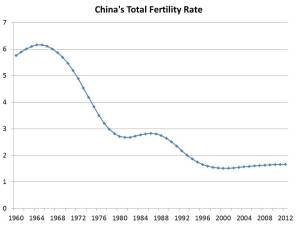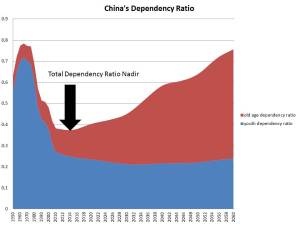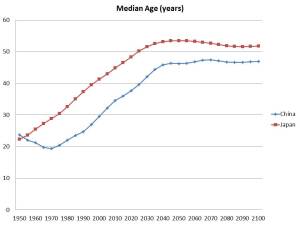Around this year*, China will reach or have reached an important turning point in their demographics. The total dependency ratio will begin increasing after 50 years of decreasing. China’s dependency ratio is projected to increase for decades and to surpass that of the United States in about 40 years.
China’s tremendous economic growth over the past few decades has lifted hundreds of millions out of poverty and has resulted in hundreds of millions of its citizens living longer and healthier lives. While there are many factors that played a role in this historic economic boom, one is demographics.
China’s fertility rate dropped sharply in the 1970s. In 1969 China’s total fertility rate (TFR) was 5.7. This means that an average of 5.7 children would be born if a woman were to live to the end of her childbearing years and bear children according to the age-specific fertility rates in 1969. The TFR had plummeted to 2.9 by 1978 and in 1979 China introduced the One Child Policy. The fertility rate fell below the replacement rate (approximately 2.1) in the early 90’s and today stands around 1.6.
When China had a high fertility rate, a large percent of its population was young. Between 1950 and 1980, more than one-third of the population, and sometimes more than two-fifths of the population, was less than 15 years old.
During this same time period, the ratio of the number of young people (defined here as less than 15) to the number of people of working age (15-64) ranged from 0.56 to 0.72. This ratio, known as the youth dependency ratio, was much higher than the old age dependency ratio. The old age dependency ratio (the ratio of the number of people over 65 to the number of people 15-64) ranged between 0.07 and 0.09. The sum of the youth dependency ratio and the old age dependency ratio represents the total dependency ratio which ranged between 0.63 and 0.78 from 1950-80.
The sharp fertility drop and sustained long-term lower fertility has produced very predictable outcomes in terms of demographics. During the first few decades after the decline in fertility, the youth dependency ratio declined (as there were less children being born) while the old age dependency rate increased. Because the fertility drop was so quick in the 1970’s, the youth dependency ratio declined more rapidly than the old age dependency ratio increased. As a result, for a few decades the total dependency ratio declined. This total dependency ratio was 0.69 in 1980 fell to 0.48 in 2000 and is currently around 0.37. Populations that have low dependency ratios can grow rapidly if there are sufficient investments in education, job opportunities, and other areas.
Now, 45 years from the start of the sharp fertility decline in China, we have reached a turning point. The total dependency ratio will increase after decreasing steadily for 50 years. China’s old age dependency ratio is growing rapidly as people live longer and there are less workers are available to support their expenses. While population estimates always have some level of uncertainty, this turning point in the dependency ratio is happening now and marks a long-term shift for China.
China will “grow old” in a similar manner of Japan, who experienced a sharp fertility drop in the 50’s (from TFR of 4.3 in 1949 to below replacement by the late 50s). In fact, demographically one can think of Japan as being about three decades ahead of China in terms of its benefits and challenges (with, of course, some major differences such as scale and relative average wealth).
The Chinese government is aware of this turning point in the dependency ratio but the details of exactly how this demographic shift will impact economics, geopolitics, and society more broadly remains to be seen.
*This analysis is based on population estimates from the World Population Prospects (2012) Medium Variant.



